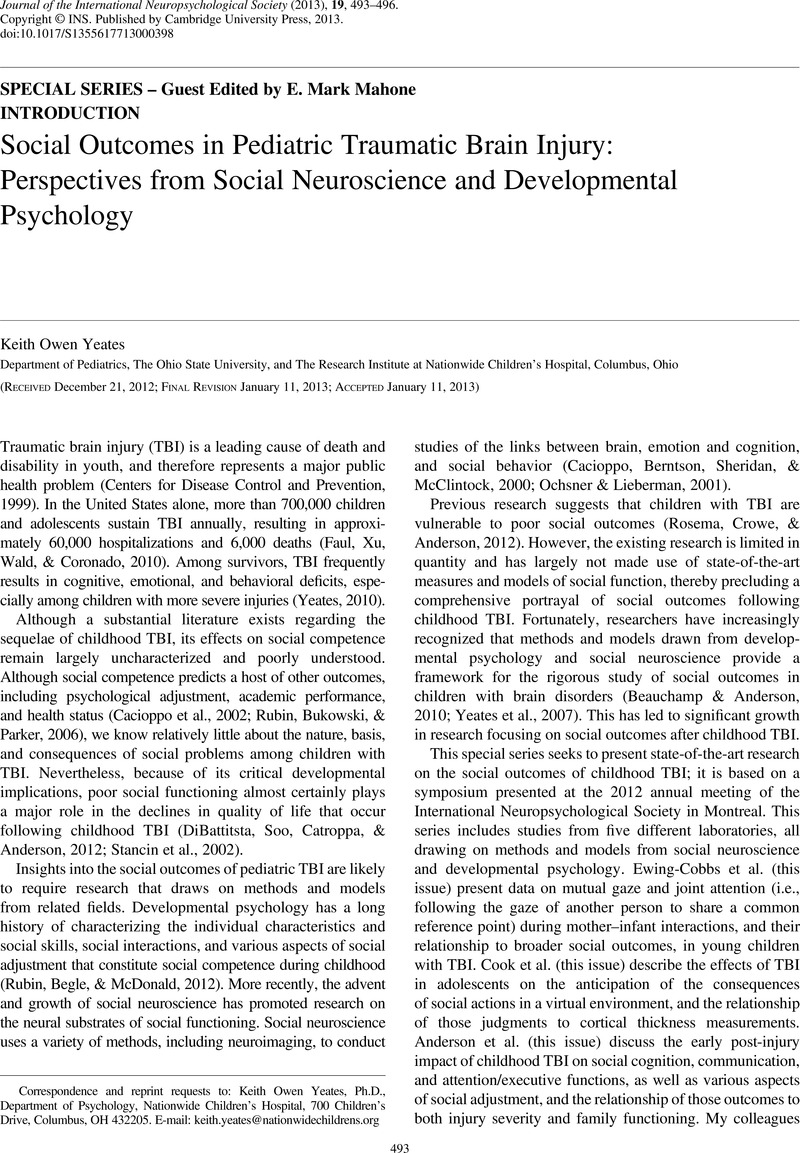Crossref Citations
This article has been cited by the following publications. This list is generated based on data provided by Crossref.
Babikian, Talin
Merkley, Tricia
Savage, Ronald C.
Giza, Christopher C.
and
Levin, Harvey
2015.
Chronic Aspects of Pediatric Traumatic Brain Injury: Review of the Literature.
Journal of Neurotrauma,
Vol. 32,
Issue. 23,
p.
1849.
Ryan, Nicholas P.
Catroppa, Cathy
Godfrey, Celia
Noble-Haeusslein, Linda J.
Shultz, Sandy R.
O’Brien, Terence J.
Anderson, Vicki
and
Semple, Bridgette D.
2016.
Social dysfunction after pediatric traumatic brain injury: A translational perspective.
Neuroscience & Biobehavioral Reviews,
Vol. 64,
Issue. ,
p.
196.
Mrazik, Martin
Brooks, Brian L.
Jubinville, Andrea
Meeuwisse, Willem H.
and
Emery, Carolyn A.
2016.
Psychosocial Outcomes of Sport Concussions in Youth Hockey Players.
Archives of Clinical Neuropsychology,
Vol. 31,
Issue. 4,
p.
297.
Atay, Christina
Ryan, Sarah J.
and
Lewis, Fiona M.
2016.
“Trying to Get a Grip”: Language Competence and Self-Reported Satisfaction With Social Relationships Three Decades Post-Childhood Traumatic Brain Injury.
Journal of Head Trauma Rehabilitation,
Vol. 31,
Issue. 5,
p.
E30.
Ciccia, Angela Hein
Beekman, Leah
Ditmars, Emily
DePompei, Roberta
and
Glang, Ann
2018.
A clinically focused systematic review of social communication in pediatric TBI.
NeuroRehabilitation,
Vol. 42,
Issue. 3,
p.
331.
Genova, Helen M.
Haight, Alison
Natsheh, Joman Y.
DeLuca, John
and
Lengenfelder, Jean
2019.
The Relationship Between Social Communication and Social Functioning in Pediatric TBI: A Pilot Study.
Frontiers in Neurology,
Vol. 10,
Issue. ,
Wiseman-Hakes, Catherine
Saleem, Madiha
Poulin, Valérie
Nalder, Emily
Balachandran, Peraveena
Gan, Caron
and
Colantonio, Angela
2020.
The development of intimate relationships in adolescent girls and women with traumatic brain injury: a framework to guide gender specific rehabilitation and enhance positive social outcomes.
Disability and Rehabilitation,
Vol. 42,
Issue. 24,
p.
3559.
Ionio, Chiara
Lista, Gianluca
Veggiotti, Pierangelo
Colombo, Caterina
Ciuffo, Giulia
Daniele, Irene
Landoni, Marta
Scelsa, Barbara
Alfei, Enrico
and
Bova, Stefania
2022.
Cognitive, Behavioral and Socioemotional Development in a Cohort of Preterm Infants at School Age: A Cross-Sectional Study.
Pediatric Reports,
Vol. 14,
Issue. 1,
p.
115.
Scafidi, Susanna
Jernberg, Jennifer
Fiskum, Gary
and
McKenna, Mary C.
2022.
Metabolism of Exogenous [2,4-13C]β-Hydroxybutyrate following Traumatic Brain Injury in 21-22-Day-Old Rats: An Ex Vivo NMR Study.
Metabolites,
Vol. 12,
Issue. 8,
p.
710.
Chuang, Ya‐Chen
Alcantara, Ace
Fabris, Gloria
Abderezaei, Javid
Lu, Tse‐An
Melendez‐Vasquez, Carmen V.
and
Kurt, Mehmet
2023.
Myelination dictates axonal viscoelasticity.
European Journal of Neuroscience,
Vol. 57,
Issue. 8,
p.
1225.
Anderson, Vicki
Hearps, Stephen J. C.
Catroppa, Cathy
Beauchamp, Miriam H.
and
Ryan, Nicholas P.
2023.
What predicts persisting social impairment following pediatric traumatic brain injury: contribution of a biopsychosocial approach.
Psychological Medicine,
Vol. 53,
Issue. 8,
p.
3568.



